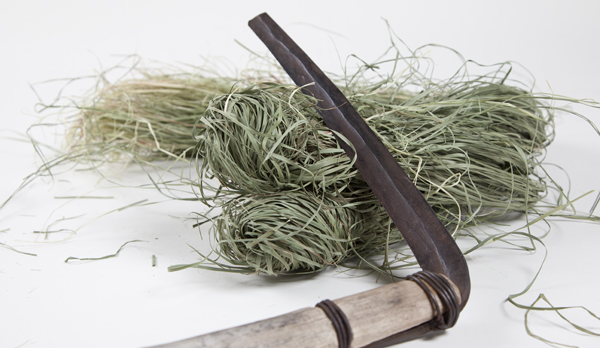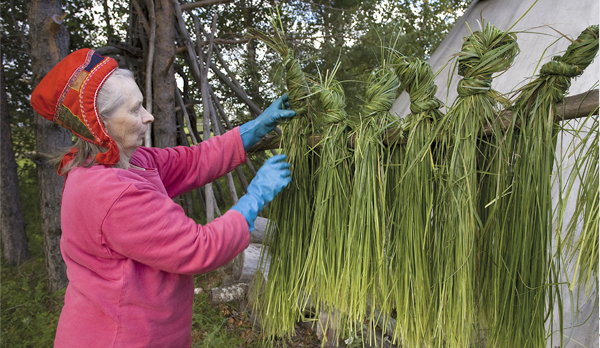Shoe grass belongs to the core area of Sámi traditional knowledge. Earlier, shoe grass was a necessity for the Sámi both in winter and summer. To protect and insulate the foot, it was used both in reindeer fur boots in winter and in leather shoes in summer. Even today, the collection and treatment of shoe grass is considered as a basic skill in the Arctic, although shoe grass is nowadays seldom used in everyday life.
August is the best time to collect shoe grass. At that time, the sedge – the material of shoe grass – is at its tallest but has not yet ripened. The best lunar season for cutting the grass is during the waxing moon, that is when the moon is growing. The best sedges for shoe grass are tall, solid and flexible and grow in wet places and on creeks; the species that can be used are the water sedge (Lat. Carex aquatilis) and the bottle sedge (Lat. Carex rostrata). The grass can be cut with a Sámi knife, a bigger sheath knife, an ordinary sickle or a special shoe grass sickle with a rather straight blade. You take a big bundle of sedges in your hand, cut it by the base with the other hand and tie it into a knot at one end.
Immediately after cutting all the grass you want, you open the knots and soften the harder base ends of the sedges by thrashing them and by rubbing them by hand. The traditional tool for softening shoe grass is a wooden club (šluppot in Sámi) made from birch; its other end has been whittled down into a handle, while the thick end is used for hammering the grass soft. When hammering, you can use a roundish rock as a bed. The soft sedges are tied again into bundles and dried in an airy place. Dried shoe grass can be stored in a dry and cool place either in an airy dowlas bag or so that several bundles have been spun and twisted together into a ball.
In the old times, shoe grass was a necessity. Today, it is seldom used in everyday life. Collecting and preparing shoe grass takes time, and using it is messy. New materials from wool to technical fibers have replaced it as the insulation used in boots. Nevertheless, the skill of collecting, preparing and stuffing boots with shoe grass is considered a culturally important skill in the Sámi community. Shoe grass is used, for example, in Sámi handicraft: new fur boots and reindeerskin shoes are stuffed with it to give them a good form and to keep the form when they stored. Fresh, new shoe grass with its good smell makes one remember the intensive summer along the stream in the north.







